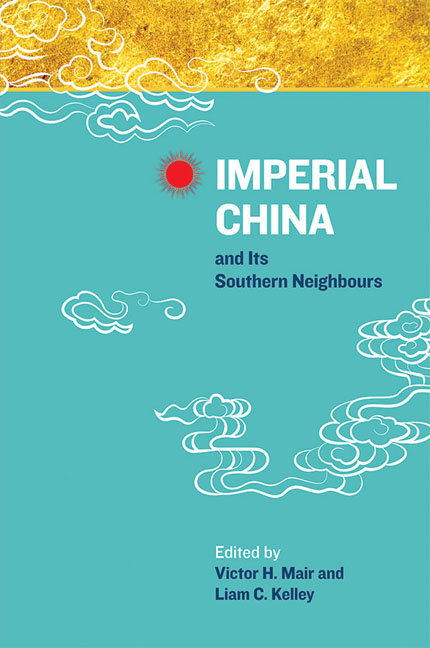Book contents
- Frontmatter
- Contents
- Preface
- The Contributors
- 1 Introduction: Imperial China Looking South
- 2 Layers of Meaning: Hairstyle and Yue Identity in Ancient Chinese Texts
- 3 Sinicization and Barbarization: Ancient State Formation at the Southern Edge of Sinitic Civilization
- 4 Clothes Make the Man: Body Culture and Ethnic Boundaries on the Lingnan Frontier in the Southern Song
- 5 What Makes a Chinese God? or, What Makes a God Chinese?
- 6 Dragon Boats and Serpent Prows: Naval Warfare and the Political Culture of China's Southern Borderlands
- 7 Inventing Traditions in Fifteenth-century Vietnam
- 8 Epidemics, Trade, and Local Worship in Vietnam, Leizhou Peninsula, and Hainan Island
- 9 Southeast Asian Primary Products and their Impact on Chinese Material Culture in the Tenth to Seventeenth Centuries
- 10 New Evidence on the History of Sino'arabic Relations: A Study of Yang Liangyao's Embassy to the Abbasid Caliphate
- 11 The Peacock's Gallbladder: An Example of Tibetan Influence in Late Imperial China
- 12 Transformation of the Yunnanese Community Along the Sino–burma Border During the Nineteenth and Early Twentieth Centuries
- 13 How the North Tried to Pacify the South Through Ritual Practices: On the Origins of the Guan Suo Opera in the Nineteenth Century
- 14 Realms Within Realms of Radiance, or, can Heaven Have Two Sons? Imperial China as Primus Inter Pares among Sino–pacific Mandala Polities
- Index
- Nalanda-Sriwijaya Series
3 - Sinicization and Barbarization: Ancient State Formation at the Southern Edge of Sinitic Civilization
Published online by Cambridge University Press: 06 January 2018
- Frontmatter
- Contents
- Preface
- The Contributors
- 1 Introduction: Imperial China Looking South
- 2 Layers of Meaning: Hairstyle and Yue Identity in Ancient Chinese Texts
- 3 Sinicization and Barbarization: Ancient State Formation at the Southern Edge of Sinitic Civilization
- 4 Clothes Make the Man: Body Culture and Ethnic Boundaries on the Lingnan Frontier in the Southern Song
- 5 What Makes a Chinese God? or, What Makes a God Chinese?
- 6 Dragon Boats and Serpent Prows: Naval Warfare and the Political Culture of China's Southern Borderlands
- 7 Inventing Traditions in Fifteenth-century Vietnam
- 8 Epidemics, Trade, and Local Worship in Vietnam, Leizhou Peninsula, and Hainan Island
- 9 Southeast Asian Primary Products and their Impact on Chinese Material Culture in the Tenth to Seventeenth Centuries
- 10 New Evidence on the History of Sino'arabic Relations: A Study of Yang Liangyao's Embassy to the Abbasid Caliphate
- 11 The Peacock's Gallbladder: An Example of Tibetan Influence in Late Imperial China
- 12 Transformation of the Yunnanese Community Along the Sino–burma Border During the Nineteenth and Early Twentieth Centuries
- 13 How the North Tried to Pacify the South Through Ritual Practices: On the Origins of the Guan Suo Opera in the Nineteenth Century
- 14 Realms Within Realms of Radiance, or, can Heaven Have Two Sons? Imperial China as Primus Inter Pares among Sino–pacific Mandala Polities
- Index
- Nalanda-Sriwijaya Series
Summary
Introduction
Past researchers have traditionally viewed ancient Southeast Asia as having been influenced by a virtually unidirectional flow of culture and civilization. Prior to the mid-1960s, many researchers explained the development of large-scale, complex societies (e.g., kingdoms and states) in Southeast Asia by pointing to influence from the more “advanced” civilizations of ancient India and China, citing the transmission of advanced technology and political models by diffusion, migration, or simple military and cultural imposition. Traditional perspectives from the early twentieth century viewed Southeast Asian societies as derivatives of Indian and Chinese counterparts. Intensified archaeological research efforts in recent decades throughout much of the region, however, have increasingly shown these sorts of positions to be untenable, demonstrating a model of unidirectional influence to be overly simplistic. To be sure, communities all over Southeast Asia were in either direct or indirect contact with one another and counterparts in India and China. But the countries of “China”, “India”, and Vietnam of today did not exist at 2000 BP, and the wider region was home to a kaleidoscope of societies. Modes of interaction and resultant social changes were complex, multilateral, and multidirectional. Societies were engaged in significant forms of interaction that included extensive long-distance trade, the movement of peoples and ideas, and cycles of peaceful relations and warfare.
This situation of complex interactions is evident throughout much of Southeast Asia, and the area of modern-day northern Vietnam is no exception. In this paper, I examine the important cultural frontier that existed between emerging Sinitic and proto-Vietnamese civilizations during the closing centuries BC, focusing specifically on archaeological evidence from the Red River Delta. To reconstruct cultural developments for the area's pre-and proto-history, a combination of textual and archaeological sources are crucial for understanding amorphous cultural boundaries and changing patterns of sociopolitical and economic interactions. During the first centuries BC and AD, the Han Empire began annexing the Red River Delta, as related by historical accounts and other traditions. At the time, a number of important cultural changes were taking place in the adjacent areas of modernday southern China and northern Vietnam.
- Type
- Chapter
- Information
- Imperial China and Its Southern Neighbours , pp. 43 - 79Publisher: ISEAS–Yusof Ishak InstitutePrint publication year: 2015

